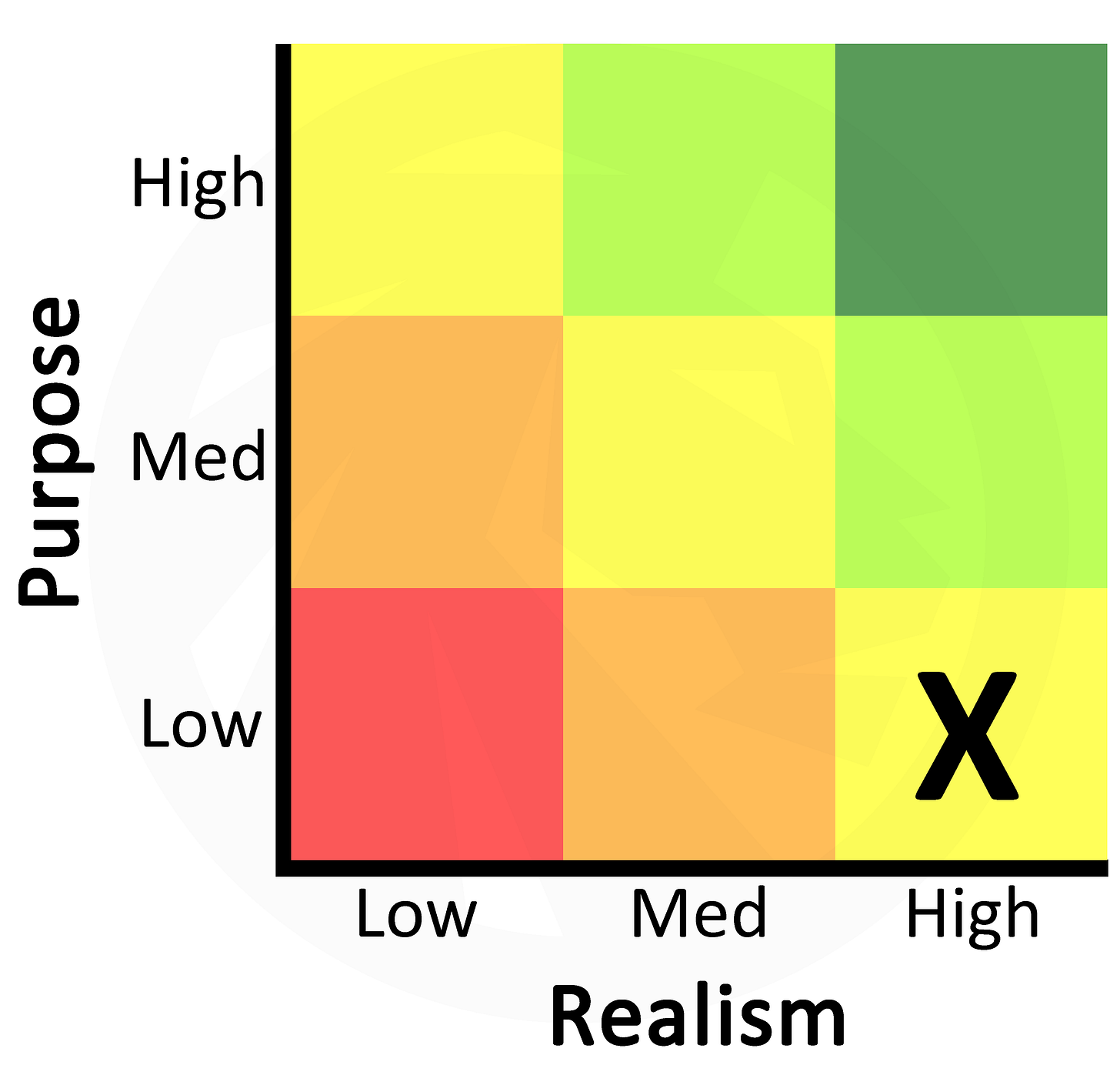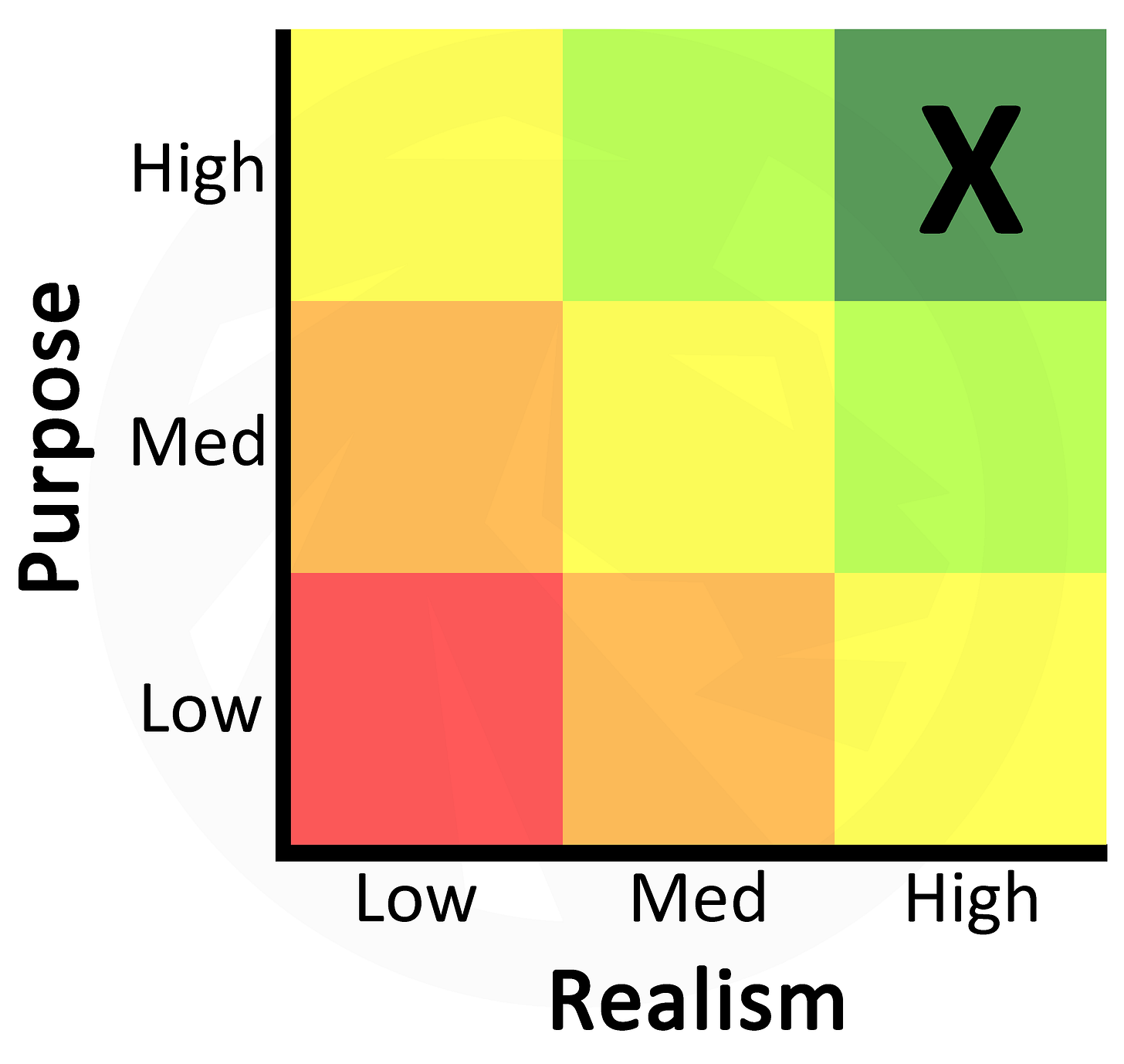This article aims to provide a framework for evaluating the various activities commonly used in Stage 2-4 group practices. In this context, activities describes both games and drills.
I evaluate practice activities based on two factors:
Realism, or "How well does the activity represent the conditions and situations players will face in competition?"
and
Purpose, or "What are we trying to improve?"
These factors are rated individually, and may or may not be concurrent; therefore, an activity can be purposeful, but not realistic, and vice-versa.
Realism
Why?: The closer a game is to competition, the better the skills being practiced will transfer.
Evaluating Criteria: Activities are evaluated based on how many of the following elements of competition-realism they represent:
Are one or more of the phases of play (offense, neutral, defense) represented?
Are players making decisions similar to those they would make in a match?
Are the players under pressure?
Is there a serve and return?
Does the activity present a competition-realistic work to rest ratio?
Does the activity promote match-optimal positioning and recovery?
Does the activity promote match/situation-optimal tactics and strategies?
Is the activity being scored?
Purpose
Why?: Purposeless practice is pointless.
Evaluating Criteria: We know that deliberate practice is:
Highly Structured
Specific & Relevant
Targeted, Monitored, & Measureable
Mentally & Physically Focused
Therefore, purposeful activities have two components, a specific and relevant goal, paired with targeted, monitored, and measurable feedback.
Goal: What are we trying to improve?
Goals may be tactical, technical, mental, or physical; however, all goals must be specific, as well as relevant to success in competition.
Ineffective activities often do not have a well-defined goal, or the goal in question would be better served with a different activity altogether. Examples of ineffective goals can be seen in the following table:
The most frequent ineffective goal is to “Win,” where players are encouraged to win by any means. Not only is this a vague goal (lacking a ‘how?’), it potentially discourages players from making the changes necessary for growth. Furthermore, (as will be discussed in the next section), because players may be successful with sub-optimal tactics/techniques, through simple randomness or opponent error, activities with a “win goal” may not provide effective feedback.
Feedback: Was the player successful in accomplishing the goal?
Feedback is necessary for players to make corrections. A chart of potential feedback forms, as well as their benefits and drawbacks, can be found below:
*I do not consider these to be highly-effective forms of feedback, for the stated reasons.
Activity Evaluation Matrix
Effective activities are both realistic and purposeful; therefore, I have created the following matrix to assist in evaluating drills and games:
This evaluative framework is applied to several common practice activities below.
Activity: Dingles
Overview: Players are 4 to a court, with all 4 playing at once in teams of 2. Each player on a team covers half of the court, including the doubles alley. Points can be played crosscourt or down the line (coach’s choice). Both players on a team feed balls in the mandated direction and the points are played out in their respective half courts. Once one point ends, the players yell “DINGLES” and the remaining point becomes full court. Teams play to a defined number of points.
Realism Score: Low (1)
Explanation:
Purpose Score: Low (1)
Explanation: Dingles has several unspecific goals that would be better served by other activities.
-Win the game (no other direction or focus given).
-Improve rallying crosscourt/down the line (no direction or focus given, the game only provides potential reps within the situation).
-Improve ‘doubles’ play (again, only by putting the player in a vaguely doubles-like situation).
Composite Score: Low-Low (2)
Evaluation: Because dingles does not have well-defined goals, it is reliant on the situations its rules create to promote learning/decision-making and to provide feedback. However, because Dingles is also highly unrealistic, it is therefore an ineffective practice activity.
Activity: Matchplay
Overview: Players play practice matches with no further instructions or rule changes.
Realism Score: High (3)
Explanation: Playing practice matches is the closest one can get to live competitive play in practice. However, the pressure in practice may be lower than an actual tournament.
Purpose Score: Low (1)
Explanation: Playing matches is an activity with a non-specific “Win” goal.
Furthermore, the situations encountered may be too random for effective feedback to be given, and changes made. For example, if a player is instructed to “Bend your knees on those low balls,” but the player does not receive a low ball for the next few games, how likely is it that they will incorporate that feedback?
Composite Score: High-Low (4)
Evaluation: Matchplay is integral for development, as it provides a barometer for both the coach and player to gauge progress; however, in my opinion it is not an efficient use of practice time. Matchplay can be greatly improved by adding purpose, either through specific goal-setting, scoring adjustments, constraints, or feedback systems (e.g. charting).
Activity: Situation Training
Overview: Rather than choosing a specific situation, I’m going to evaluate the concept of situation training as defined in my previous article: Situation Training: A Better Way to Practice.
Realism Score: High (3)
Explanation:
Situation training takes a snapshot of the situations faced within competitive play. Depending on the situation, this may be a weak 3 if there is no serve and return.
Purpose Score: High (3)
Explanation: Situation training is specific and relevant, as each situation has defined tactical goals. Feedback is gathered in a myriad of ways, with scalable targets, direct coach feedback, and progress charting. Furthermore, because situation training provides standardized repetitions of the situation in question, players are able to incorporate the feedback received in their performance.
Composite Score: High-High (6)
Evaluation: In my opinion, situation training is the most effective practice structure.
If you are a coach or parent, I would invite you to apply this matrix to your own games and drills. Let me know what you think!













